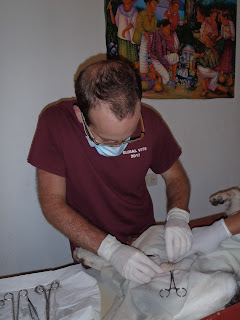 |
| Lake Atitlan |
It is difficult to describe the feeling you get while walking the streets of Guatemala: Hearing the sound of tortillas being sculpted by hand or howler monkey roars echoing through the trees, seeing volcanoes in the distance or Mayan descendents in colourful traditional clothing, hearing the waves crashing against a lancha or the local pharmacy blasting Eminem featuring 50 cent songs (with no censors).
 |
| Volcan Agua in Antigua |
It hasn't been all fun and games here though, there has been a lot adjusting to: The smell of black exhaust billowing out of chicken buses, the sight of deceased dogs on the side of the road as a result of car collisions, and flying down bumpy streets in a tuk tuk with no seat belts or doors.
 |
| A chicken bus in Panajachel |
Another interesting sight is the local newspaper. We looked through about 5 pages and saw 6 pictures of dead bodies on the street. Newspapers here do not sugar coat their stories at all! Locals aren't phased by the sight of dead bodies and use the pictures to identify the deceased.
If a person is caught stealing or trying to murder someone, vigilante justice can occur. We heard stories about a man who was caught robbing several tuk tuk drivers and killed by Mayan descendants for his crimes. Mayan law is to leave the deceased body in the streets for 72 hours so everyone can see the consequences if you choose to steal. We were told about another story of a man who tried robbing a chicken bus and shot at 2 Mayan descendant women. The rest of the women charged at the man and successfully caught him for the police. However, once in jail, Mayan descendants protested outside the doors for the man to be released so he could face the consequences of his actions. The mob grew larger and larger to the point where police had no choice but to release him. To make a long story short, he spent his 72 hours in the street as well.
During our last lancha boat ride home in Panajachel, the water was choppy and the driver loaded the boat to double capacity. We were sinking and tipping side to side so much that we thought the boat was going to flip over or water would rush in through the sides. Michelle, Terri, Mike and I were shooting each other looks of extreme fear while everyone else seemed to not even notice! The most reasurring part was when a few Guatemalan men at the back of the boat started laughing and grabbing life jackets from the roof. We heard them counting in Spanish, "17 life jackets for 31 people." They seemed to think it was pretty hilarious.
 |
| Michelle on a lancha at normal capacity |
 |
| Michelle on a lancha at double capacity |
 |
| Way too many people... |
On a brighter note, something else we will not forget is the stunning clothing worn by Mayan descendants. Women wear intricately hand woven skirts, belts, and shirts that differ in colour depending on the region in which they live. They are also able to balance just about anything on their head with ease. We have yet to figure out how they walk around so casually with 20 or 30 lbs of items on their heads.


As our 5 weeks of hard work comes to an end, we are already starting to miss the country we so quickly fell in love with. Stay tuned for our last blog posts about the sterilization clinic we are helping to organize and run on July 28th.
Adios!
Sabrina










































